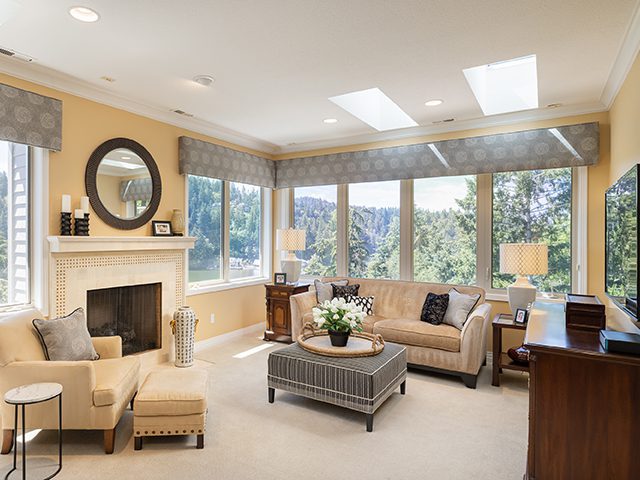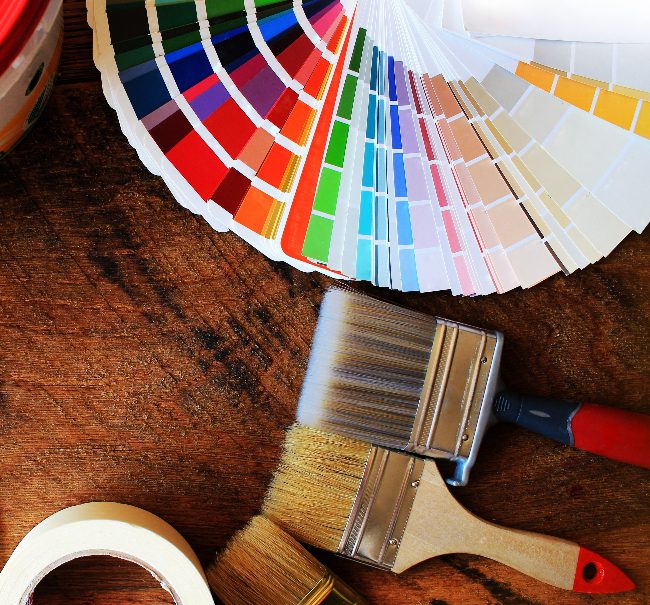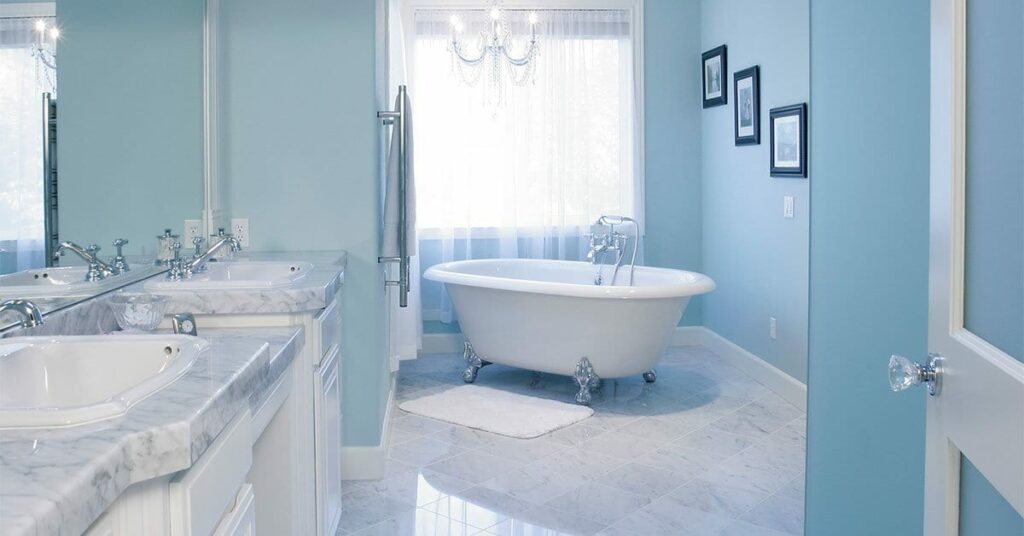We can see it now: you’re looking at a large living room or dining room wall, knowing it needs a new color, but not sure which color it needs. It’s probably one of the most common questions we get when it comes to a home remodel. When it comes time to give those rooms an immediate facelift, here’s how to choose paint colors for your home.
Now, we realize you may have a few favorite cool paint colors that you’ve just been waiting to splash on your walls. However, if you’re looking to establish a particular mood, there are a few things you’ll want to consider. Remember: you may be in love with a bright mango orange as an accent wall today, but will you love that color tomorrow, too?
How will it affect the feel of the room? For a cozy breakfast nook, light pastels are great for creating an inviting atmosphere where overly dark or intense colors can make the space feel cramped and less inviting. Why have an aggressive start to your day if you don’t have to?
Choosing the Right Paint Colors
The color of a room might seem insignificant to some people, but the reality is that different paint colors can have a drastic effect on the look and feel of a room. When deciding what color to choose, it can be overwhelming having so many different options. The most important thing to consider when picking out paint is the intention. The 2024 color of the year is a soft, pinkish- orange hue called “Peach Fuzz,” a great option to bring some life into a space.
Is the goal to make the room feel inviting, soothing, or energizing? When remodeling a room, identifying the intent behind it considerably helps when creating a color theory for a room. Luckily, Metke Remodeling and Luxury Homes have a team of professional interior designers who are experts at assisting clients in picking out paint and making everything in a room come together.
 How Does Light Affect Paint Color
How Does Light Affect Paint Color
One element to focus on that varies from room to room is the lighting. When you’re in the paint store looking at samples, chances are there are bright lights so you can see the color you’re comparing, contrasting, and eventually choosing. But how often do you get home with the sample can, get it on the wall, and it’s not even remotely the same?
That’s because you have a different kind of light in your home as opposed to a Sherwin-Williams or Lowe’s home improvement store. Either during the day or at night when you have a variety of different light sources. And while you can choose the wattage of your overhead lights or lamps, there’s not much you can do with the natural light coming into your home.
So take advantage of it. Depending on the location of the room and windows, the paint on the walls will receive either more or less natural light. For north-facing windows, there won’t be any direct sunlight, which will provide a cooler luminosity within the room.
For rooms with southern-facing windows, there will be more even, natural light. Eastern-facing windows will give the room a warmer feel from the rising sun. And for windows that face the West, there will be a very warm light within the room from the afternoon and setting sun.
The different amount of natural light affects the warmth, which in turn helps to determine more suitable color options for that room. For areas with north-facing windows, it would be a good idea to paint the walls a warmer color to counterbalance the lack of natural sunlight. And vice versa for west-facing windows. There is more flexibility with colors for windows facing the South and East.
Choosing Accent Colors
The general idea when it comes to accent colors is to complement the main color of the room. While a piece of art and even furniture can certainly add some pops of complementary colors, trim pieces, accent walls, and other spaces can make main colors more dominant. Use a color wheel to identify complementary shades for a cohesive feel, going lighter or darker as needed.
The 60-30-10 rule is a fundamental guideline for achieving a balanced and visually appealing color scheme in interior painting. It suggests allocating percentages to different colors within a room: 60% for the dominant color (main walls), 30% for the secondary color (furniture, fabrics), and 10% for accent colors.
This rule ensures a harmonious blend of colors, preventing overwhelming or disjointed visuals. By maintaining this proportional distribution, you create a cohesive and aesthetically pleasing atmosphere that enhances the overall design and feel of the space.
Paint Color Choices And Feng Shui
People can apply Feng Shui to almost any surrounding environment, from gardens to bedrooms and even public spaces in a city. There is a lot that goes into Feng Shui as it has been around for thousands of years and is very prevalent in many cultures. When it comes to color schemes and Feng Shui, there are a lot of meanings behind each color.
Feng Shui originated in ancient China as a way to create harmony within an environment. And while some people might want to use specific colors because of their perceived meaning, that is not good Feng Shui practice. Just because a color is lucky or has a particular purpose behind it does not mean it needs to be on all the walls.
Feng Shui Paint Color Categories
Reluctantly choosing a color can create feelings of resentment and negative energy. In other words, bad Feng Shui. Understanding the different colors and their energies will help when choosing paint for every room. The elements of Feng Shui are broken down into five categories:
- Wood
- Fire
- Earth
- Metal
- Water
Wood Element Colors
Green represents health and renewal. Using multiple shades of green in a room will help to increase the positive energy and create a feeling of rejuvenation. Brown is a very grounding color, representative of the wood element. Using this color creates a feeling of stability.
 Fire Element Colors
Fire Element Colors
Red is a bold color option. In many cultures, red is positive and represents luck, marriage, love, and passion. Yellow is a happy and nourishing color that represents the fire and earth elements. Yellow will provide a cozy and cheerful feeling to a room, optimal for kitchens or children’s bedrooms.
Orange represents a fire element similar to red and yellow. But if those colors are too bold for a room, orange is a great alternative, it promotes conversations and invokes comfortable feelings.
Purple is often associated with royalty or nobility. It is advised to use this color cautiously as an entire room painted purple might be overbearing but is useful for meditation spaces. Pink is more than the color of love; it also provides a room with a gentle and soothing feeling.
Earth Element Colors
Yellow and brown are repeated here from the above fire element colors. Yellow imparts a warm and cheerful ambiance, bringing a sense of coziness but also radiates a nurturing energy. Brown, a highly grounding color, embodies the essence of the wood element. Incorporating this color fosters a sense of stability and rootedness.
Metal Element Colors
White is a clean, fresh color that represents the metal element and can be very satisfying in the right applications. Gray is a very neutral color, and, when used correctly, can create a sophisticated look.
Water Element Colors
Black, like space or the deep ocean, represents the unknown. It can be used nearly anywhere in the home and brings a strong energy to the room. Blue is representative of the water element and provides a feeling of tranquility. There are hundreds of variations of blue for any room or preference, from ocean to sky blue, the possibilities are endless.
Using different colors for some regions of a house will help lend themselves to the energy and ambiance of a room. It is an excellent idea to consider applying Feng Shui when redesigning a room. The team at Metke Remodeling and Luxury Homes is not only skilled and experienced at creating beautiful homes but has won awards and achievements for their high-quality work and exceptional customer service!
Different Types Of Paint Sheen
The sheen of paint does affect the appearance but also the ease of cleaning. Colors with a high-gloss sheen are easy to clean but draw attention to any dents or scratches. This type of paint is best suited for trims and moldings, not for walls. Semi-gloss paint is less shiny and relatively simple to clean.
It is a popular option for bathrooms and kitchens, areas with high humidity because the gloss helps protect the walls from moisture. The most popular paint, sheen, is eggshell. It’s the best of both worlds paint, it holds up well to cleaning and hides imperfections on the wall.
Regardless of the type of paint you are choosing, always check with a specialist because levels of sheen can vary from brand to brand.
Home Remodeling Experts Are Here to Help You Choose Paint Colors
Metke Remodeling and Luxury Homes strives to provide every client with the remodel of their dreams. Everyone is unique, and the work that Metke does reflects each person’s personality in the design with unmatched quality. Regardless if it’s a bedroom, bathroom, or whole-home remodel, the experts at Metke Remodeling and Luxury Homes are here to provide their services with the utmost craftsmanship and customer service.

